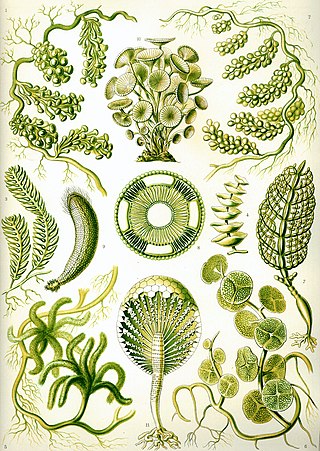
The Chlorophyceae are one of the classes of green algae, distinguished mainly on the basis of ultrastructural morphology. They are usually green due to the dominance of pigments chlorophyll a and chlorophyll b. The chloroplast may be discoid, plate-like, reticulate, cup-shaped, spiral- or ribbon-shaped in different species. Most of the members have one or more storage bodies called pyrenoids located in the chloroplast. Pyrenoids contain protein besides starch. Some green algae may store food in the form of oil droplets. They usually have a cell wall made up of an inner layer of cellulose and outer layer of pectose.

Chlorophyta is a division of green algae informally called chlorophytes.

Hydrodictyaceae is a family of green algae in the order Sphaeropleales. They are found in freshwater habitats worldwide.
Ankyra is a genus of green algae in the family Characiaceae. This genus of algae is closely related to Atractomorpha and Sphaeroplea. They are found in stagnant waters.

Characium is a genus of green algae in the family Characiaceae. It is very commonly found in freshwater habitats, where it is attached to phytoplankton or zooplankton.
Dictyochloris is a genus of green algae in the class Chlorophyceae. It is the sole genus of the family Dictyochloridaceae. It is commonly found in terrestrial and subaerial habitats.

Kirchneriella is a genus of green algae in the family Selenastraceae. It is found in freshwater habitats, as phytoplankton or metaphyton.

Lagerheimia is a genus of green algae in the family Oocystaceae. It is commonly found in freshwater habitats all over the world, although some species are rare and have only been recorded from Europe or the United States.
Lobocharacium is a genus of green algae in the family Characiosiphonaceae. It contains the single species Lobocharacium coloradoense. It has been isolated from a pond in Colorado, United States.

Monactinus is a genus of green algae in the family Hydrodictyaceae. It is very common in freshwater regions throughout the world.

Planktosphaeria is a genus of Chlorophyceae of the green algae. It was first described by the phycologist Gilbert Morgan Smith in 1918, with Planktosphaeria gelatinosa as its type species. Species of Planktosphaeria are commonly found in freshwater plankton around the world.
Pseudomuriella is a genus of green algae, specifically of the class Chlorophyceae. It is the sole genus of the family Pseudomuriellaceae. It is a terrestrial alga that inhabits soils.

Schroederia is a genus of green algae in the family Schroederiaceae. Schroederiaceae is a monotypic taxon; Schroederia is its only genus.

Trebouxia is a unicellular green alga. It is a photosynthetic organism that can exist in almost all habitats found in polar, tropical, and temperate regions. It can either exist in a symbiotic relationship with fungi in the form of lichen or it can survive independently as a free-living organism alone or in colonies. Trebouxia is the most common photobiont in extant lichens. It is a primary producer of marine, freshwater and terrestrial ecosystems. It uses carotenoids and chlorophyll a and b to harvest energy from the sun and provide nutrients to various animals and insects.

Actidesmium is a small genus of green algae in the family Characiaceae. It was described by the German phycologist Paul Friedrich Reinsch in 1875.
Deuterocharacium is a genus of green algae in the family Characiaceae. It is found in freshwater habitats, attached to algae or detritus. It is rare and has only been recorded from Europe.

Chlorotetraedron is a genus of green algae, in the family Neochloridaceae. The name may also be written as Chlorotetraëdon. It is found as freshwater plankton or in soil.
Poloidion is a genus of green algae in the family Neochloridaceae, containing the single species Poloidion didymos. It is an extremely rare genus, which has only been recorded once on moist soil and rocks in Austria.

Chlorochytriaceae is a family of algae within the order Chlamydomonadales. Alternatively, it shows some morphological similarity to Characiosiphonaceae and closely related to it. It contains a number of parasitic taxa endophytic within vascular plants, mosses, or other algae.
Bracteamorpha is a genus of green algae in the order Sphaeropleales, and is the only genus in the family Bracteamorphaceae. It contains a single species, Bracteamorpha trainorii.











